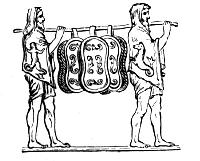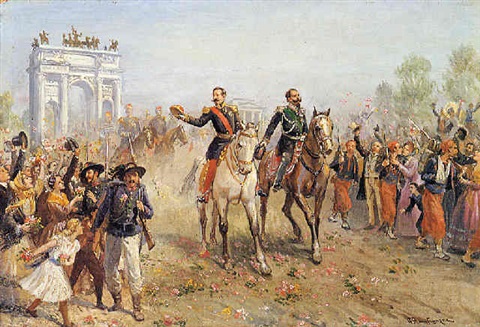Passa la nave mia colma d’oblio
per aspro mare, a mezza notte il verno,
enfra Scilla et Caribdi; et al governo
siede ’l signore, anzi ’l nimico mio.
A ciascun remo un penser pronto et rio
che la tempesta e ’l fin par ch’abbi a scherno;
la vela rompe un vento humido eterno
di sospir’, di speranze, et di desio.
Pioggia di lagrimar, nebbia di sdegni
bagna et rallenta le già stanche sarte,
che son d’error con ignorantia attorto.
Celansi i duo mei dolci usati segni;
morta fra l’onde è la ragion et l’arte,
tal ch’incomincio a desperar del porto.
My ship, full of oblivion, sails
on a bitter sea, at winter’s midnight,
between Scylla and Charybdis: at the helm
sits that Lord, or rather my enemy.
At each oar there’s a cruel eager thought,
that scorns the tempest and its end:
the sail’s torn by an eternal moist wind
of sighs, of hopes, and of desire.
A rain of tears, a mist of disdain
drench and slacken the already tired shrouds,
woven from error and ignorance.
My two usual guiding lights are so hidden:
reason and art so drowned by the waves,
that I begin to despair of finding harbour.
http://www.theserendipityperiodical.it/2018/05/15/il-sonetto-influenze-da-petrarca-a-shakespeare/
"Quello che risulta curioso dell’influenza di Petrarca sul poeta elisabettiano è il lungo giro che permise la diffusione del genere sul suolo britannico e portò alla nascita di una delle opere più studiate in lingua inglese, i sonetti shakespeariani. Hyland [3] fa notare come il bardo iniziò a scrivere tali composizioni negli anni 90 del XVI secolo dando un importante contributo a una forma che esisteva in quel contesto da poco più di cinquant’anni. Quasi sicuramente l’elisabettiano non lesse mai l’opera in italiano e forse non conobbe mai l’origine di questa forma che gli assicurò una larga fortuna. Infatti, colui che importò il sonetto nella prima metà del ‘500 fu il diplomatico Sir Thomas Wyatt a cui si deve l’introduzione del distico finale rimato che cambia la struttura del sonetto, “making it tends towars a neat conclusion in the final two lines”. .... "
Non escludo che il Bardo abbia letto Petrarca in Italiano.
Shall I compare thee to a summer’s day?
Thou art more lovely and more temperate:
Rough winds do shake the darling buds of May,
And summer’s lease hath all too short a date:
Sometime too hot the eye of heaven shines,
And often is his gold complexion dimm’d;
And every fair from fair sometime declines,
By chance or nature’s changing course untrimm’d;
But thy eternal summer shall not fade
Nor lose possession of that fair thou owest;
Nor shall Death brag thou wander’st in his shade,
When in eternal lines to time thou growest:
So long as men can breathe or eyes can see,
So long lives this and this gives life to thee.
Dovrei paragonarti a un giorno d'Estate?
Tu sei più amabile e più tranquillo.
Impetuosi venti scuotono le tenere gemme di Maggio,
E il corso dell'estate ha fin troppo presto una fine.
Talvolta troppo caldo splende l'occhio del cielo,
E spesso la sua pelle dorata s'oscura;
Ed ogni cosa bella la bellezza talora declina,
spogliata per caso o per il mutevole corso della natura.
Ma la tua eterna estate non dovrà svanire,
Né perder la bellezza che possiedi,
Né dovrà la morte farsi vanto che tu vaghi nella sua ombra,
Quando in eterni versi nel tempo tu crescerai:
Finché uomini respireranno o occhi potran vedere,
Queste parole vivranno, e daranno vita a te.























_14.jpg/800px-Monumento_a_Dante_Alighieri_(Trento)_14.jpg)



